Municipalities of Estonia
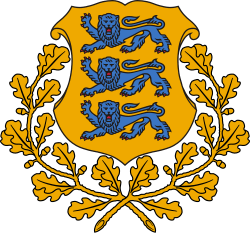 |
|---|
| This article is part of a series on the politics and government of Estonia |
|

A municipality (Estonian: omavalitsus, plural omavalitsused) is the smallest administrative subdivision of Estonia. Each municipality is a unit of self-government with its representative and executive bodies. The municipalities in Estonia cover the entire territory of the country.
Municipalities in Estonia are of two types: urban municipalities or towns (linnad, singular linn) and rural municipalities or parishes (vallad, singular vald). There is no other status distinction between them.
Municipalities may contain one or several settlements. All urban municipalities plus 6 rural municipalities contain only one settlement. Of the latter six, 5 are so-called "borough-parishes", consisting of one borough, while Ruhnu Parish consists of one village.
Some municipalities are divided into districts. The 8 urban districts (linnaosad, singular linnaosa) of Tallinn have limited self-government, while other urban districts are formed for administrative purposes. Some rural districts (osavallad) have limited self-government, while other types of rural districts do not.
Municipalities range in population from Tallinn with 427,500 inhabitants to Ruhnu with 68.[1] Previously, as over two-thirds of the municipalities had a population of under 3,000, many of them found it advantageous to co-operate in providing services and carrying out administrative functions.
Currently, after the administrative reform was completed in October 2017, there are total of 79 municipalities, 14 of which are urban and 65 rural. After the reform small municipalities with under 5,000 inhabitants have been reduced from a number of 169 to 15. The number of councillors was reduced from 2,026 to 1,019. By county, the municipalities are:
Harju County
16 municipalities (4 urban, 12 rural)
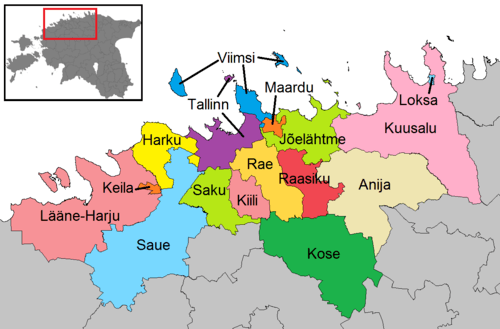
Urban municipalities:
Rural municipalities:
- Anija Parish (includes the town of Kehra and the borough of Aegviidu)
- Harku Parish
- Jõelähtme Parish
- Kiili Parish (includes the borough of Kiili)
- Kose Parish
- Kuusalu Parish
- Lääne-Harju Parish (includes the town of Paldiski)
- Raasiku Parish
- Rae Parish
- Saku Parish
- Saue Parish (includes the town of Saue)
- Viimsi Parish
Hiiu County
1 rural municipality
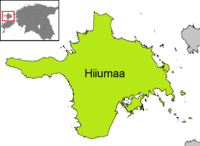
Rural municipality:
- Hiiumaa Parish (includes the town of Kärdla)
Ida-Viru County
8 municipalities (3 urban, 5 rural)

Urban municipalities:
- Kohtla-Järve
- Narva
- Narva-Jõesuu
- Sillamäe
Rural municipalities:
- Alutaguse Parish
- Jõhvi Parish (includes the town of Jõhvi)
- Lüganuse Parish (includes the towns of Kiviõli and Püssi)
- Toila Parish (includes the borough of Kohtla-Nõmme)
Järva County
3 municipalities (1 urban, 2 rural)
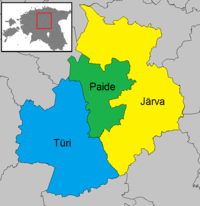
Urban municipalities:
- Paide
Rural municipalities:
- Järva Parish (includes the borough of Järva-Jaani)
- Türi Parish (includes the town of Türi)
Jõgeva County
3 rural municipalities
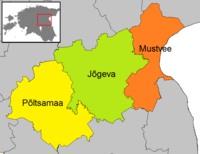
Rural municipalities:
- Jõgeva Parish (includes the town of Jõgeva)
- Mustvee Parish (includes the town of Mustvee)
- Põltsamaa Parish (includes the town of Põltsamaa)
Lääne County
3 municipalities (1 urban, 2 rural)
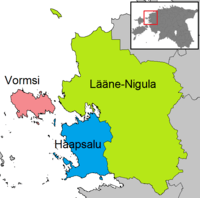
Urban municipality:
Rural municipalities:
Lääne-Viru County
8 municipalities (1 urban, 7 rural)
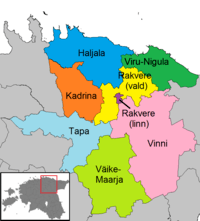
Urban municipalities:
Rural municipalities:
- Haljala Parish
- Kadrina Parish
- Rakvere Parish
- Tapa Parish (includes the town of Tamsalu and Tapa)
- Vinni Parish
- Viru-Nigula Parish (includes the town of Kunda)
- Väike-Maarja Parish
Pärnu County
7 municipalities (1 urban, 6 rural)

Urban municipalities:
- Pärnu (includes the boroughs of Lavassaare and Paikuse)
Rural municipalities:
- Häädemeeste Parish
- Kihnu Parish
- Lääneranna Parish (includes the town of Lihula)
- Põhja-Pärnumaa Parish (includes the boroughs of Pärnu-Jaagupi, Tootsi and Vändra)
- Saarde Parish (includes the town of Kilingi-Nõmme)
- Tori Parish (includes the town of Sindi)
Põlva County
3 rural municipalities
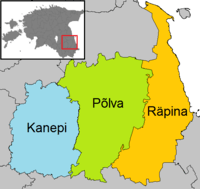
Rural municipalities:
- Kanepi Parish
- Põlva Parish (includes the town of Põlva)
- Räpina Parish (includes the town of Räpina)
Rapla County
4 rural municipalities

Rural municipalities:
- Kehtna Parish (includes the borough of Järvakandi)
- Kohila Parish (includes the borough of Kohila)
- Märjamaa Parish (includes the borough of Märjamaa)
- Rapla Parish (includes the town of Rapla)
Saare County
3 rural municipalities

Rural municipalities:
- Muhu Parish
- Ruhnu Parish
- Saaremaa Parish (includes the town of Kuressaare)
Tartu County
8 municipalities (1 urban, 7 rural)

Urban municipalities:
- Tartu
Rural municipalities:
- Elva Parish (includes the town of Elva)
- Kambja Parish
- Kastre Parish
- Luunja Parish
- Nõo Parish
- Peipsiääre Parish (includes the town of Kallaste)
- Tartu Parish
Valga County
3 urban municipalities
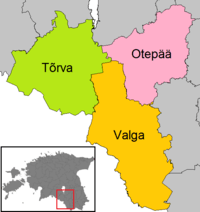
Rural municipalities:
- Otepää Parish (includes the town of Otepää)
- Tõrva Parish (includesthe town of Tõrva)
- Valga Parish (includesthe town of Valga)
Viljandi County
4 municipalities (1 urban, 3 rural)
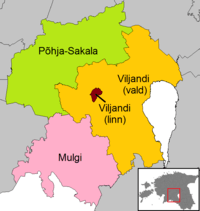
Urban municipality:
Rural municipalities:
- Mulgi Parish (includes the towns of Abja-Paluoja, Karksi-Nuia and Mõisaküla)
- Põhja-Sakala Parish (includes the towns of Suure-Jaani and Võhma)
- Viljandi Parish
Võru County
5 municipalities (1 urban, 4 rural)

Urban municipality:
Rural municipalities:
- Antsla Parish (includes the town of Antsla)
- Rõuge Parish
- Setomaa Parish
- Võru Parish
Structure of local authorities
In each municipality there is a local government as well as a council.
The council (volikogu) is a representative body elected by the residents of a municipality for a term of three years. The members of the council elect a chairman (volikogu esimees), who organises the council's work and represents the municipality.
The government (valitsus) is an executive body formed by the council. It is headed by a mayor (linnapea in towns, vallavanem in parishes), who is appointed for a four-year term. The mayor cannot be the chairman of the council. Other members of the government are chosen by the mayor with the approval of the council.
Former municipalities
The list of municipalities that have merged or lost existence between 1995 and 2017.
- 1996
- Pärnu-Jaagupi borough was merged into Halinga Parish
- 1998
- Abja-Paluoja town was merged into Abja Parish
- 1999
- Otepää town and Pühajärve Parish formed Otepää Parish
- Lihula town was merged into Lihula Parish
- Võsu borough was merged into Vihula Parish
- Karksi-Nuia town wasmerged into Karksi Parish
- Kaarma Parish and Kuressaare Parish formed Kaarma Parish
- Antsla town was merged into Antsla Parish
- 2002
- Kehra town was merged into Anija Parish
- Rapla town was merged into Rapla Parish
- Räpina town was merged into Räpina Parish
- Kohila borough was merged into Kohila Parish
- Märjamaa borough, Märjamaa Parish and Loodna Parish formed Märjamaa Parish
- 2005
- Tapa town, Saksi Parish and Lehtse Parish formed Tapa Parish
- Jõhvi town was merged into Jõhvi Parish
- Kuusalu Parish and Loksa Parish formed Kuusalu Parish
- Kilingi-Nõmme town, Saarde Parish and Tali Parish formed Saarde Parish
- Suure-Jaani town, Olustvere Parish, Suure-Jaani Parish and Vastemõisa Parish formed Suure-Jaani Parish
- Türi town, Türi Parish, Oisu Parish and Kabala Parish formed Türi Parish
- Tamsalu town was merged into Tamsalu Parish
- 2009
- Kaisma Parish and Vändra Parish formed Vändra Parish
- 2013
- Pärsti Parish, Paistu Parish, Viiratsi Parish and Saarepeedi Parish formed Viljandi Parish
- Põlva town was merged into Põlva Parish
- Kose Parish and Kõue Parish formed Kose Parish
- Lavassaare borough was merged into Audru Parish
- Kärdla town and Kõrgessaare Parish formed Hiiu Parish
- Oru Parish, Risti Parish and Taebla Parish formed Lääne-Nigula Parish
- Püssi town, Maidla Parish and Lüganuse Parish formed Lüganuse Parish
- 2014
- Kaarma Parish, Kärla Parish and Lümanda Parish formed Lääne-Saare Parish
- 2017
- Aegviidu borough was merged into Anija Parish
- Keila Parish, Padise Parish, Vasalemma Parish and Paldiski town formed Lääne-Harju Parish
- Saue town, Saue Parish, Kernu Parish and Nissi Parish formed Saue Parish
- Hiiu Parish, Emmaste Parish, Käina Parish and Pühalepa Parish formed Hiiumaa Parish
- Kiviõli town, Lüganuse Parish and Sonda Parish formed Lüganuse Parish
- Alajõe Parish, Iisaku Parish, Illuka Parish, Mäetaguse Parish and Tudulinna Parish formed Alutaguse Parish
- Toila Parish, Kohtla Parish and Kohtla-Nõmme borough formed Toila Parish
- Vaivara Parish was merged to Narva-Jõesuu town
- Albu Parish, Ambla Parish, Imavere Parish, Järva-Jaani, Kareda Parish, Koeru Parish and Koigi Parish formed Järva Parish
- Türi Parish, Väätsa Parish and Käru Parish formed Türi Parish
- Paide Parish and Roosna-Alliku Parish were merged into Paide town
- Jõgeva town, Jõgeva Parish, Palamuse Parish, most of Torma Parish and some parts of Puurmani Parish formed Jõgeva Parish
- Põltsamaa town, Põltsamaa Parish, Pajusi Parish andmost of Puurmani Parish formed Põltsamaa Parish
- Mustvee town, Kasepää Parish, Saare Parish, Lohusuu Parish, Avinurme Parish and some parts of Torma Parish formed Mustvee Parish
- Ridala Parish was merged into Haapsalu town
- Lääne-Nigula Parish, Martna Parish, Kullamaa Parish, Nõva Parish and Noarootsi Parish formed Lääne-Nigula Parish
- Viru-Nigula Parish, Aseri Parish and Kunda town formed Viru-Nigula Parish
- Haljala Parish and Vihula Parish formed Haljala Parish
- Rakvere Parish and Sõmeru Parish formed Rakvere Parish
- Tapa Parish and Tamsalu Parish formed Tapa Parish
- Väike-Maarja Parish and Rakke Parish formed Väike-Maarja Parish
- Vinni Parish, Laekvere Parish and Rägavere Parish formed Vinni Parish
- Audru Parish, Tõstamaa Parish and Paikuse Parish were merged into Pärnu town
- Lihula Parish, Hanila Parish, Koonga Parish and Varbla Parish formed Lääneranna Parish
- Halinga Parish, Vändra Parish, Vändra borough and Tootsi borough formed Põhja-Pärnumaa Parish
- Tori Parish, Are Parish, Sauga Parish and Sindi town formed Tori Parish
- Häädemeeste Parish and Tahkuranna Parish formed Häädemeeste Parish
- Saarde Parish and Surju Parish formed Saarde Parish
- Põlva Parish, Laheda Parish, Ahja Parish, Mooste Parish and Vastse-Kuuste Parish formed Põlva Parish
- Kanepi Parish, Valgjärve Parish and Kõlleste Parish formed Kanepi Parish
- Räpina Parish, Veriora Parish and Meeksi Parish formed Räpina Parishˇ
- Rapla Parish, Juuru Parish, Kaiu Parish and most of Raikküla Parish formed Rapla Parish
- Märjamaa Parish, Vigala Parish and some parts of Raikküla Parish formed Märjamaa Parish
- Järvakandi borough was merged into Kehtna Parish
- Kuressaare town, Lääne-Saare Parish, Salme Parish, Torgu Parish, Kihelkonna Parish, Mustjala Parish, Leisi Parish, Pihtla Parish, Valjala Parish, Orissaare Parish, Pöide Parish and Laimjala Parish formed Saaremaa Parish
- Tähtvere Parish was merged into Tartu town
- Elva town, Konguta Parish, Rannu Parish, Rõngu Parish, Puhja Parish and parts of Puka Parish and Palupera Parish formed Elva Parish
- Tartu Parish, Laeva Parish, Piirissaare Parish and Tabivere Parish formed Tartu Parish
- Kallaste town, Peipsiääre Parish, Alatskivi Parish, Vara Parish and Pala Parish formed Peipsiääre Parish
- Kambja Parish and Ülenurme Parish formed Kambja Parish
- Haaslava Parish, Mäksa Parish and Võnnu Parish formed Kastre Parish
- Valga town, Karula Parish, Taheva Parish, Tõlliste Parish and Õru Parish formed Valga Parish
- Otepää Parish, Sangaste Parish and parts of Puka Parish and Palupera Parish formed Otepää Parish
- Tõrva town, Helme Parish, Hummuli Parish and Põdrala Parish formed Tõrva Parish
- Viljandi Parish, Tarvastu Parish and Kolga-Jaani Parish formed Viljandi Parish
- Suure-Jaani Parish, Kõpu Parish, Kõo Parish and Võhma town formed Põhja-Sakala Parish
- Abja Parish, Karksi Parish, Halliste Parish and Mõisaküla town formed Mulgi Parish
- Võru Parish, Lasva Parish, Sõmerpalu Parish, Vastseliina Parish and Orava Parish formed Võru Parish
- Antsla Parish and Urvaste Parish formed Antsla Parish
- Rõuge Parish, Haanja Parish, Varstu Parish, Mõniste Parish and most of Misso Parish formed Rõuge Parish
- Meremäe Parish, Värska Parish, Mikitamäe Parish and some parts of Misso Parish formed Setomaa Parish
See also
References
- ↑ "Archived copy". Archived from the original on 2002-06-19. Retrieved 2002-06-19.
External links
- Local Government Reform by the Estonian Institute.
- Local Government Reform by the Institute of Baltic Studies.
- Administrative Division of Estonia at the Institute of the Estonian Language website.